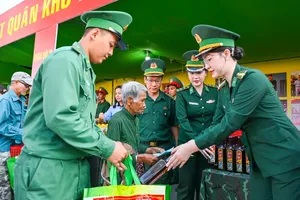This is an honor and a heavy responsibility, requiring soldiers stationed in remote areas to maintain strict routines to observe and detect, ensuring that no target on the sea or in low-altitude airspace is missed. Their resilience and spirit of overcoming challenges play a vital role in safeguarding the sovereignty of the seas and islands, ensuring peace for the country.

Steadfastly holding the position
Among the seven islands, including Hon Khoai, Tho Chau, Hon Chuoi, Nam Du, Hon Doc, Phu Quoc, and Con Dao, visited by the Ho Chi Minh City delegation, Hon Khoai in Ngoc Hien District, Ca Mau Province, is the only one without a population. To reach the island, the delegation had to travel by boat for nearly an hour to the pier, then follow a winding 3 km path through a primeval forest to reach Radar Station 595, Regiment 551, Naval Region 5, located 318 meters above sea level.
According to Captain Nguyen Dinh Phuc, Head of Radar Station 595, there are no residents on the island. As a result, the soldiers utilize every available piece of land to grow vegetables and raise livestock and poultry to improve their meals. Freshwater for daily use and production is collected from stored rainwater. The water supply is made safe through an RO filtration system donated by the Party, government, military, and residents of HCMC.
These efforts not only ensure a local food source but also run alongside the unit's training activities. Despite the challenges, the officers and soldiers collaborate with the Forestry Ranger Department, the Border Guard Station at Hon Khoai, and the lighthouse station to actively engage in rescue operations and forest fire prevention. They also conduct regular patrols and guard duties to maintain the safety of their unit and the surrounding area.
Commuting on Hon Chuoi (Ca Mau) is more challenging than on Hon Khoai. The path leading up to Radar Station 615 is steep, with nearly 400 steps, some so vertical that an adult must stretch fully to climb. Navy soldiers at Radar Station 615 ascend and descend this slope dozens of times a day.
Senior Lieutenant, Professional Soldier Nguyen Trung Khac, an officer at Radar Station 615, has spent nearly a decade on Hon Chuoi. He recalls feeling "shocked" when he first arrived, not only by the tough terrain but also by the island's seasonal migration lifestyle. The island's residents live on one side of the island for half the year and the other side for the remainder. "The fishermen’s homes are temporary, often just bamboo frames with tarps. Moving quickly and cheaply is essential for those who live off the sea," Khac explained.
Hon Doc, belonged to the Hai Tac (Pirate) archipelago, situated in Tien Hai Commune, Ha Tien City, Kien Giang Province, is more accessible than Hon Chuoi. It is the largest island in the archipelago, covering an area of 11 square kilometers, and is located near the border with Kep Province in Cambodia. The island serves as an important trading route between the two countries. A sovereignty marker erected in 1958 on the Western side of Hon Doc lists the names of surrounding islands. Locals still refer to the island as Hai Tac, a name derived from its history of pirate activity.
From the observation tower at Radar Station 625, several islands in Cambodia's Kep Province can be clearly seen, located more than 3 nautical miles away. The radar waves act as an "eye," monitoring movements in the waters of Ha Tien, including illegal fishing and smuggling activities. The naval radar serves as a reconnaissance tool, guiding law enforcement forces to gather information and address any emerging situations.
Major Phung Si Chung, Head of Radar Station 625, shared, “On this remote island, we, the naval soldiers, are dedicated to protecting the sovereignty of our territory and ensuring the safety of the people. We hope our families and loved ones remain healthy, and the people on the mainland can trust us and feel assured. We promise to carry out our mission to the best of our ability.”
Not letting any target slip by
Captain Do Dinh Nam, Head of Radar Station 605, explained that their station's mission was to observe and detect targets at sea and in low-altitude airspace, identify their type and actions, and promptly report this information to higher command and coordinating units. He added that they also verified, guided, and directed forces to take action when necessary.
At the unit's observation post, following the request of Colonel Trinh Xuan Tung, Commander of the Naval Region 5, Senior Lieutenant, Professional Soldier Phan Ngoc Dai, a staff member at the station, gave a clear and comprehensive presentation on the structure, technical features, and tactical use of telescopes, the main observation directions, and the targets detected during the shift. Inside the operations room, the atmosphere was busy and urgent, as targets continuously appeared on the radar.
Pointing to the small, dense dots on the radar screen, Major, Professional Soldier Dau Hong Son reported that these were the targets detected by the radar, which included military ships, cargo vessels, and fishing boats. When a new target appeared on the radar, Colonel Trinh Xuan Tung instructed the operator to identify and classify the type of vessel. Within two minutes, the station’s staff confirmed the target as a cargo ship. To verify the report, the Commander asked the Operations Director to use telescopes from the observation post for further confirmation.
Colonel Trinh Xuan Tung expressed his satisfaction with the professionalism and responsibility of the soldiers and encouraged them. He emphasized that the area the unit was responsible for monitoring had high volumes of maritime traffic, making it a hotspot for smuggling, illegal immigration, and potential violations of illegal, unreported, and unregulated (IUU) fishing.
He stressed that the officers and soldiers at the station needed to remain vigilant, maintain strict discipline in terms of personnel, equipment, and duty shifts, and actively observe and detect all targets to ensure none were missed. He noted that this was crucial for maintaining security, order, and safety at sea, and for collaborating with other forces to protect the sovereignty of the nation’s seas and islands.
Big brother of Radar Station 620
Major, Professional Soldier Nguyen Hai Dang, Team Leader of Radar Station 620, Regiment 551, has been committed to the Southwestern seas and the radar stations of Naval Region 5 for nearly 30 years. Since taking on his role in 1999, he has consistently shown a strong sense of responsibility, initiative, and dedication.
He understands the vital role his team plays in protecting the sea and the importance of the radar station as the "all-seeing eye" safeguarding the waters. With the motto "Entering the control room is like entering a combat position," he leads by example in training and conducting observations, especially under challenging weather conditions. He also consistently educates his soldiers on the significance of the Southwestern seas and the mission of the radar station.
Over the past five years, under his leadership, the team has successfully completed its mission without errors or lapses in vigilance, particularly regarding critical targets. His comrades affectionately call him "Big Brother."
























